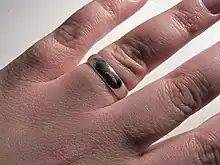
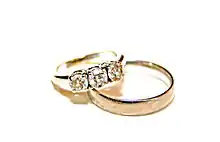
A wedding ring or wedding band is a finger ring that indicates that its wearer is married.[1] It is usually forged from metal, traditionally gold or another precious metal.[2] Rings were used in ancient Rome during marriage.[3]
Depending on the culture, a wedding ring is typically worn on the base of the left ring finger; if the wearer is left-handed, often it will go onto the right hand. The ring finger is widely claimed to be associated with the traditional belief known as vena amoris ("vein of love").
History

The Western traditions of wedding rings can be traced to ancient Rome and Greece, and were first associated with the marital dowry and later with a promise of fidelity. The modern exchange of rings derived from the customs of Europe in the Middle Ages as part of Christendom. It is from these cultures that the choice of the ring finger was chosen, as it was believed that there was a vein from the left ring finger that ran directly to the heart.[4]
Historical styles
Gimmel rings
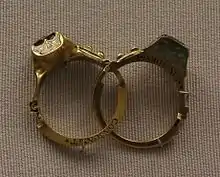
During the 16th and 17th centuries, European husbands bestowed a gimmel ring upon their wives. Similar to the puzzle ring, the gimmel ring consisted of two interlocking bands. The bride and groom both wore one of these bands after their engagement, and the two bands were reunited during the wedding ceremony. Subsequently, the wife wore the combined ring.[5]
Poesy rings
The poesy ring was a style of ring that was popular during the Renaissance era. It was a band of sterling silver inscribed with a poem or "poesy".[5]
Other styles
Different cultures used many other historical styles of wedding ring. According to popular legend, in the Middle East, a puzzle ring, consisting of many bands that interlock to create a finished ring, would be given by the husband as a wedding ring, because if the wife removed it (presumably to commit adultery), the bands of the ring would fall apart, and she would be unable to reassemble it before its absence would be noticed.[6] However, a puzzle ring can be easily removed without the bands falling apart.
The fede ring, being a band consisting of two hands clasped in betrothal, is another historical custom of Europe that ostensibly dates from antiquity.
Limited gold content in the United Kingdom
In 1942 during the Second World War, British wartime restrictions on the manufacture of jewelry resulted in "utility" wedding rings that were limited to a maximum mass of two pennyweights, being slightly heavier than 3 grams (0.11 oz), and were forged of 9 carat gold rather than the traditional 22 carat.[7] The Regional Assayer Office hallmarked these rings, which guaranteed their gold content and compliance with the wartime regulations with a special utility mark adjacent to the mark for the year on the inside of the band; the hallmark resembled a capital "U" with the bottom curve absent or two parentheses enclosing a space, i. e., "()".
Double-ring ceremony
The double-ring ceremony describes the exchange of wedding rings by and for both spouses. In several European nations such as the Nordic countries, it is common to exchange plain engagement rings of the same form for both sexes, and typically, an additional, more precious, and bejeweled wedding ring is given to the bride. In the nuptials, the groom's ring becomes a wedding ring also, and can be bestowed anew by the bride as a part of the wedding ceremony. The engagement is commonly a matter of agreement between the two, and the wedding rings are chosen together. Both engagement and wedding rings are worn on the left hand, the bride having both rings together. Occasionally, the groom receives a separate wedding ring. In Germany and Austria, both parties use engagement rings worn on the left hand. At the nuptials, a wedding ring is placed on the right hand, as in several east European nations, including Bulgaria, Poland, and Russia. This can be a new ring for the bride or both, or reusing the engagement rings. Any engagement rings can then remain on the left hand or be transferred to the right hand. In Germany, it has been customary for both the bride and the groom to wear a wedding ring since at least the 1870s[8] and mentions of couples exchanging rings during the wedding ceremony in the Netherlands can be found at least as far back as 1815.[9] In both the United States and Canada, wedding rings were initially only worn by wives, but became customary for both spouses during the 20th century.[10] In Brazil, Mexico, and Spain both sexes also wear engagement rings, and the groom's ring often becomes a wedding ring in the nuptial exchange ceremony. In The Netherlands plain bands can be worn on either hand, left for Catholics and right for Protestants. When engaged, both bride and groom wear what will be the wedding band on the opposite hand and switch hands after the wedding.
Compositions and styles
In Western nations, wedding rings are often forged of gold, palladium, platinum, argentium silver, titanium, tungsten, or more recently, silicone.[11][12] Common engravings on the inside of the ring include the name of one's spouse, the names of both spouses, the date of the wedding or a phrase of significance to the spouses. In many nations the engagement rings are plain while the bride's wedding ring commonly is bejeweled.
Some customs include the wedding ring as the final of a series of gifts, which also may include the engagement ring, traditionally given as a betrothal present. This custom was practiced in ancient Rome.[13]
Cultural practices
Wedding ceremony customs
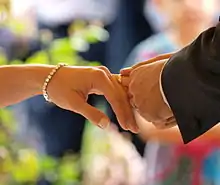
In several traditions, the best man or maid of honor has the duty of keeping track of a couple's wedding rings and to produce them at the symbolic moment of the giving and receiving of the rings during the traditional marriage ceremony. In more elaborate weddings, a ring bearer (who is often part of the family of the bride or groom) may assist in the ceremonial parading of the rings into the ceremony, sometimes on a special cushion.
In Western Christianity, engagement rings are exchanged during the betrothal rite, while wedding rings are given during the celebration of holy matrimony itself.[14] Among Eastern Orthodox, Eastern Lutheran and Eastern Catholic Christians, the exchange of rings is not technically part of the wedding service, but rather are exchanged at the betrothal. It is always a two-ring set given to her by the priest or by the best man.[13] Unlike most other Orthodox Churches, the Eastern Orthodox Christian Church of Greece has recently stopped performing betrothal blessings separately, and now a betrothal ceremony is the initial part of the wedding service. In Greece, the ceremony of betrothal may be performed immediately before the wedding (or "crowning" as it is more properly called), and the actual symbolic act of marriage is not the exchange of rings, but the crowning.
Historically, the wedding ring was connected to the exchange of valuables at the moment of the wedding rather than a symbol of eternal love and devotion, a sign of "earnest money". According to the 1549 edition of the Book of Common Prayer: after the words "with this ring I thee wed" follow the words "This gold and silver I give thee", at which point the groom was supposed to hand a leather purse filled with gold and silver coins to the bride.[15] It is a relic of the times when marriage was a contract between families, not individual lovers. Both families were then eager to ensure the economic safety of the young couple. Sometimes it went as far as being a conditional exchange as this old (and today outdated) German formula shows: "I give you this ring as a sign of the marriage which has been promised between us, provided your father gives with you a marriage portion of 1000 Reichsthalers" (approximately 20 kg (44 lb) of silver).[15]
Post-wedding customs

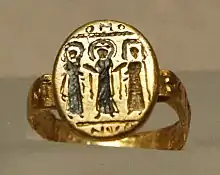
After marriage, the wedding ring is worn on the hand on which it had been placed during the ceremony. By wearing rings on their fourth fingers, married spouses symbolically declare their life-long love for and fidelity to each other. This symbol has public utility and is presently expected as a matter of tradition and etiquette, so much so that its absence is often interpreted as meaning that the person is single. Many spouses wear their wedding rings day and night. It is not uncommon for some spouses, especially those who have occupations that make the wearing of rings dangerous, such as actors, police and electrical workers, to not wear their rings on their fingers, instead wearing them on a chain around their neck. Since the 19th century in the West, it has been considered unlucky to remove a wedding ring once it has been placed on the finger in church.[16]
Some cultures exchange additional rings. In some parts of India, Hindu women may wear a toe ring or bichiya instead of a finger ring, but the bichiya is increasingly worn in addition to a finger ring. In eastern India, primarily in West Bengal, women wear an iron bangle, which may be gold- or silver-plated, called a loha. In Romania, spouses celebrate their silver wedding anniversary, i.e. twenty-fifth anniversary, by exchanging silver rings, which are worn on the fourth finger of the left hand along with their original, and usually gold, wedding rings.[17]
Wedding ceremonies that use rings
Christian
- Anglican (Book of Common Prayer): "With this ring I thee wed, with my body I thee worship, and with all my worldly goods I thee endow: in the Name of the Father and of the Son and of the Holy Ghost. Amen."[18]
- Eastern Orthodoxy: In the Eastern Orthodox Service of Betrothal, the priest makes the Sign of the Cross with rings over the bride's head while declaring three times "The servant of God (Groom) is betrothed to the handmaid of God (Bride), in the Name of the Father, and of the Son, and of the Holy Spirit. Amen". Next, it is declared three times again over the bride's head with the names reversed, after which the rings are exchanged three times, either by the priest or best man. The priest asks God "to bless this putting on of rings with a heavenly blessing and that an Angel of the Lord will go before these Your servants, all the days of their life."[19] In the Eastern Orthodox Church, wedding rings are traditionally worn on the right hand.
- Lutheran: "I give you this ring as a sign of my love and faithfulness."[20]
- Roman Catholic Church: "[Name], receive this ring as a sign of my love and fidelity. In the name of the Father, and of the Son, and of the Holy Spirit."[21] Because the equality of the spouses is emphasized in the Roman Catholic Sacrament of Marriage, generally the bride and groom each give to the other a wedding ring and recite the above formula in turn.
Mixed usage and non-use in other Christian Churches
While most Christian Churches (such as the Catholic, Lutheran, and Anglican) have the exchange of rings within their wedding liturgies, some Christian denominations eschew the use of wedding rings.
The wearing of plain dress has historically been practiced by many Methodist Churches, in keeping with the teaching of John Wesley, who stated that people should not be "adorned with gold, or pearls, or costly apparel" (this clause is contained in The General Rules of the Methodist Church).[22][23] The first Methodist liturgical text, The Sunday Service of the Methodists, omitted the ring ceremony.[24] As such, members of some Methodist Churches, such as the Allegheny Wesleyan Methodist Connection and Bible Methodist Connection of Churches, do not wear wedding rings.[25][26] However, other Methodist Churches contain the exchange of wedding rings within their services for Holy Matrimony. In the wedding liturgy for the Free Methodist Church, for example, the groom and bride say the following when exchanging rings: "This ring I give you in token and pledge of our constant faith and steadfast love".[27] "A Service of Christian Marriage, Rite I" contained in The United Methodist Book of Worship states that the exchange of rings is optional but when it is done, they are blessed and pronounced as "the outward and visible sign of an inward and spiritual grace, signifying to us the union between Jesus Christ and His Church".[28] Following this, the bride and groom state the following as they exchange rings: "[Name], I give you this ring as a sign of my vow, and with all that I am, and all that I have, I honor you; in the name of the Father, and of the Son, and of the Holy Spirit."[28]
Some conservative Mennonite groups do not wear jewelry, including wedding rings, as part of their practice of plain dress.[29] The Amish do not wear wedding rings but the men are clean shaven before marriage and grow a full beard after marriage.
Among Quaker Christians, especially Conservative Friends and Holiness Friends, the wedding ring is traditionally not worn as a part of their testimony of simplicity.[30] Among Quaker groups that do wear wedding rings, the following wording is used by the bride and groom as they are exchanged: "With this ring, I thee wed."[31] The Friends General Conference, for example, teaches that "Although wedding rings are not necessary in a Quaker wedding, the couple may exchange them if they wish. This is often done after they speak their vows."[32]
Traditionally, adherents of the Seventh-day Adventist Church do not wear wedding rings.[33] The usage of wedding rings among Seventh-day Adventists, however, has increased.[34]
Jewish
- Judaism: "You are consecrated to me with this ring according to the law of Moses and Israel." In Orthodox Judaism, only the groom declares this in Hebrew; but in Reform Judaism, both the bride and groom declare it.[35] Many Orthodox Jewish men do not wear wedding rings.
See also
- Claddagh ring
- Courtship
- Engagement ring
- Eternity ring
- Smart ring
- Use of a wedding ring as a symbol: La bottega dell'orefice, a 1989 film based on The Jeweler's Shop, a play written by Karol Józef Wojtyła
- Love
- Marriage in the Eastern Orthodox Church
- Pre-engagement ring
- Ring finger
- Mangala sutra
- Trilogy ring
- Visual markers of marital status
- Wedding ring cushion
- The marriage symbol ⚭ depicts two engaged rings
References
- ↑ "Wedding Ring". Harper Collins Dictionary (dictionary.com). Harper Collins & Son. 2016. Archived from the original on 14 September 2016. Retrieved 8 September 2016.
- ↑ "Guide to Wedding Ring Styles, Designs & Prices". The Wedding Rings. Polished Diamonds Ltd. Archived from the original on 17 September 2017. Retrieved 25 February 2022.
- ↑ Withey, Alison (March 2015). "Roman Wedding Rings". www.jewelpedia.net. Archived from the original on 25 November 2020. Retrieved 27 November 2020.
- ↑ Mowbray, Sean (6 April 2023). "The Ancient History of Wedding Rings". Discover. Retrieved 20 July 2023.
- 1 2 Hort, G.M. (1919). "Some Tradition About Rings". The Irish Monthly. 47: 650, 654.
- ↑ The Ohio Review. Ohio University. 1977. p. 31.
- ↑ Church, Rachel (2014). Rings. V&A Publishing. p. 102. ISBN 9781851777853.
- ↑ Chambers, W & R (1872). "The Ring of Rings". Chamber's Journal of Popular Literature, Science and Arts: 352.
- ↑ Gartman, Hendrik (1815). Eugenia, de zegepraal over de liefde. Hendrik Gartman. Archived from the original on 7 April 2022. Retrieved 31 October 2021.
- ↑ Howard, Vicki (2003). "A 'Real Man's Ring': Gender and the Invention of Tradition". Journal of Social History. 36 (4): 837–856. doi:10.1353/jsh.2003.0098. S2CID 144304412.
- ↑ "I ditched my wedding ring for a silicone band". Road & Track. 4 March 2015. Archived from the original on 1 June 2016. Retrieved 28 May 2016.
- ↑ "Rubber Wedding Bands: 150,000 Annual Ring Avulsion Injuries Make Silicone Wedding Rings More Popular". The Inquisitr. 24 April 2016. Archived from the original on 1 June 2016. Retrieved 28 May 2016.
- 1 2 "Ring". Encyclopædia Britannica.
The Romans are also thought to have originated the custom of betrothal rings, or engagement rings, symbolizing a promise of marriage to a member of the opposite sex.
- ↑ "Rites Relating to Marriage: A Statement and Resources from The International Anglican Liturgical Consultation" (PDF). The International Anglican Liturgical Consultation. 2011. pp. 4, 14–15. Archived (PDF) from the original on 20 September 2021. Retrieved 19 September 2021.
- 1 2 Kunz, George Frederick (1917). Rings for the Finger. J.B. Lippincott Co. Archived from the original on 10 September 2014. Retrieved 8 July 2007.
- ↑ Monger, George (2004). Marriage Customs of the World: From Henna to Honeymoons. ABC-CLIO. p. 235. ISBN 9781576079874.
- ↑ Stritof, Sheri. "History of Wedding Anniversary Gift Lists". About.com: People & Relationships – Marriage. About.com. Archived from the original on 20 October 2013. Retrieved 17 September 2013.
- ↑ The Form of Solemnization of Matrimony, Book of Common Prayer, 1662.
- ↑ "The Sacrament of Marriage According to the Rites of The Greek Orthodox Church". Greek Orthodox Archdiocese of Australia. Archived from the original on 19 April 2013. Retrieved 11 March 2013.
- ↑ "Marriage" (PDF). Lutheran Book of Worship. Augsburg Fortress. 2014. Archived (PDF) from the original on 1 November 2019. Retrieved 9 July 2018.
- ↑ "Wedding rings and marriage". 11 January 2022.
- ↑ Bunch, Taylor G. (1997). Exodus and Advent Movements in Type and Antitype. TEACH Services, Inc. p. 77. ISBN 9781572581210.
- ↑ "The General Rules of the Methodist Church". The United Methodist Church. Archived from the original on 8 July 2018. Retrieved 9 July 2018.
- ↑ Religion in Life. Abingdon Press. 1948. p. 519.
- ↑ "I. The Church". Discipline of the Allegheny Wesleyan Methodist Connection. Allegheny Wesleyan Methodist Connection. p. 31.
- ↑ "Discipline of the Bible Methodist Connection of Churches" (PDF). 2014. pp. 33–34. Archived (PDF) from the original on 2 August 2017. Retrieved 19 June 2017.
- ↑ "2007 Book of Discipline" (PDF). Free Methodist Church. 2007. p. 226. Archived (PDF) from the original on 2 April 2016. Retrieved 9 July 2018.
- 1 2 "A Service of Christian Marriage I". The United Methodist Church. 1992. Archived from the original on 28 March 2017. Retrieved 9 July 2018.
- ↑ Wenger, John C. (3 October 2000). Glimpses of Mennonite History. Wipf & Stock Publishers. p. 113. ISBN 9781579104658.
- ↑ Ranger, Kim L. (2016). "Seventh-day Quaker: A Spiritual Memoir". Grand Valley State University. Archived from the original on 22 January 2018. Retrieved 9 July 2018.
- ↑ Cartier, Marie (11 September 2014). Baby, You are My Religion: Women, Gay Bars, and Theology Before Stonewall. Routledge. p. 158. ISBN 9781317544715.
- ↑ "Faith and Practice of Northern Yearly Meeting of the Religious Society of Friends Chapter on Marriage Approved, May 2008 and Guidelines for Marriage Under the Care of Madison Monthly Meeting of the Religious Society of Friends" (PDF). Friends General Conference. 2014. p. 16. Archived (PDF) from the original on 21 October 2016. Retrieved 9 July 2018.
- ↑ Review and Herald: Official Organ of the Seventh-Day Adventist Church. Seventh-day Adventist Church. 1967. p. 14.
In the United States, Seventh-day Adventist ministers do not baptize a person wearing a wedding ring, nor do they officiate at a wedding in which the ring ceremony is part of the service.
- ↑ Spectrum: Journal of the Association of Adventist Forums. The Association. 1969. p. 47.
In 1918, Stemple White quoted John Wesley and the 1855 Methodist Discipline in an apparent protest against increasing acceptance of the wedding ring in Adventist circles.
- ↑ Blane, Steven. "Jewish Wedding". JewishWeddingTraditions.org. Archived from the original on 7 December 2014. Retrieved 3 December 2014.
External links
![]() Media related to Wedding rings at Wikimedia Commons
Media related to Wedding rings at Wikimedia Commons